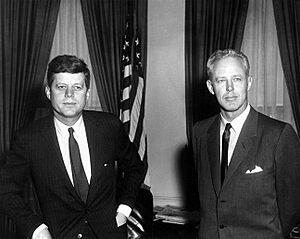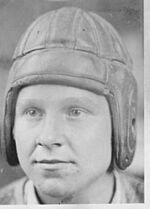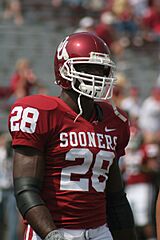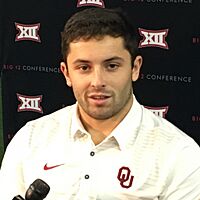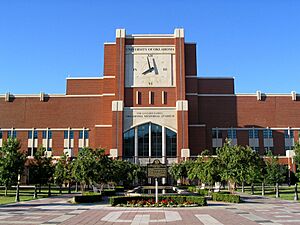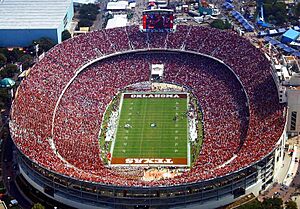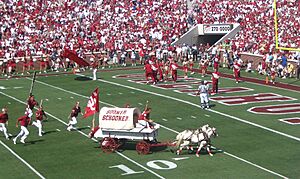Oklahoma Sooners football facts for kids
Quick facts for kids Oklahoma Sooners football |
|||
|---|---|---|---|
|
|||
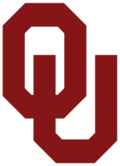 |
|||
| First season | 1895; 130 years ago | ||
| Athletic director | Joe Castiglione | ||
| Head coach | Brent Venables 3rd season, 16–10 (.615) |
||
| Stadium | Gaylord Family Oklahoma Memorial Stadium (capacity: 80,126) |
||
| Field | Owen Field | ||
| Year built | 1923 | ||
| Field surface | Grass | ||
| Location | Norman, Oklahoma | ||
| NCAA division | Division I FBS | ||
| Conference | Southeastern Conference | ||
| Past conferences | Independent (1895–1914) Southwest (1915–1919) Big Eight (1920–1995) Big 12 Conference (1996–2023) |
||
| All-time record | 944–341–53 (.725) | ||
| Bowl record | 31–25–1 (.553) | ||
| Playoff appearances | 4 (2015, 2017, 2018, 2019) | ||
| Playoff record | 0–4 (.000) | ||
| Claimed national titles | 7 (1950, 1955, 1956, 1974, 1975, 1985, 2000) | ||
| Unclaimed national titles | 10 (1915, 1949, 1953, 1957, 1967, 1973, 1978, 1980, 1986, 2003) | ||
| National finalist | 4 (2000, 2003, 2004, 2008) | ||
| Conference titles | 50 | ||
| Division titles | 8 | ||
| Rivalries | Missouri (rivalry) Nebraska (rivalry) Oklahoma State (rivalry) Texas (rivalry) |
||
| Heisman winners | Billy Vessels – 1952 Steve Owens – 1969 Billy Sims – 1978 Jason White – 2003 Sam Bradford – 2008 Baker Mayfield – 2017 Kyler Murray – 2018 |
||
| Consensus All-Americans | 82 | ||
| Current uniform | |||
 |
|||
| Colors | Crimson and Cream |
||
| Fight song | Boomer Sooner | ||
| Mascot | Sooner Schooner | ||
| Marching band | The Pride of Oklahoma Marching Band | ||
| Outfitter | Jordan | ||
The Oklahoma Sooners football team plays for the University of Oklahoma (OU) in college football. They compete at the highest level, called NCAA Division I Football Bowl Subdivision, and are part of the Southeastern Conference (SEC). The team started in 1895 and is one of the most successful in college football history. They have won 944 games and have a .725 winning percentage, which are both among the top six all-time.
The Sooners have been ranked in the AP poll 897 times, with 101 times at No. 1. This is the third-highest total ever. The team has won seven national championships and 50 conference championships. Many of their players have been named All-Americans, and seven have won the famous Heisman Trophy. Twenty-nine former players and coaches from Oklahoma are in the College Football Hall of Fame. The Sooners also hold the record for the longest winning streak in Division I history, with 47 wins in a row. They are the only team to have four different coaches win more than 100 games each.
The Sooners play their home games at Gaylord Family Oklahoma Memorial Stadium in Norman, Oklahoma. Their current head coach is Brent Venables, who started in 2022.
Contents
- History of Oklahoma Sooners Football
- Early Days: Starting the Team (1895–1904)
- Bennie Owen's Time as Coach (1905–1926)
- Coaches Between Owen and Wilkinson (1927–1946)
- Bud Wilkinson's Era of Greatness (1947–1963)
- Coaches Jones, Mackenzie, and Fairbanks (1964–1972)
- Barry Switzer's Time as Coach (1973–1988)
- Coaches Gibbs, Schnellenberger, and Blake (1989–1998)
- Bob Stoops' Era of Success (1999–2016)
- Riley and Venables: Recent Years (2017–present)
- Conference History
- Championships Won by Oklahoma
- Bowl Games Played
- Head Coaches of the Sooners
- Home Stadium: The Palace on the Prairie
- Big Rivalries
- Team Spirit and Traditions
- Awards and Honors
- Future Games
- More About Oklahoma Sooners
History of Oklahoma Sooners Football
Early Days: Starting the Team (1895–1904)
The very first football game for the University of Oklahoma was played on December 14, 1895. This was 12 years before Oklahoma even became a state! A student named John A. Harts from Kansas helped organize the team.
In their only game that season, Oklahoma lost 34–0 to a more experienced team from Oklahoma City. The game was played on a field of low grass. Several Oklahoma players, including Harts, got hurt. By the end of the game, Oklahoma even had to borrow players from the other team to have enough people on the field. After that year, Harts left to look for gold.
After playing two games without a coach in 1896, a professor named Vernon Louis Parrington became head coach in 1897. Parrington had played football at Harvard. In his four years as coach, his teams had a record of 9 wins, 2 losses, and 1 tie. After the 1900 season, football started taking too much time from Parrington's teaching. He decided to step down as coach. He later won a famous award called the Pulitzer Prize for History in 1928.
The Sooners had three more coaches over the next four seasons. Fred Roberts coached in 1901, leading the team to a 3–2 record. Mark McMahon followed, with an 11–7–3 record in 1902 and 1903. Fred Ewing coached in 1904, with a 4–3–1 record. The 1904 season also saw the first game of the Bedlam Series against in-state rival Oklahoma A&M. Oklahoma won that game 75–0.
Bennie Owen's Time as Coach (1905–1926)
After ten years, the team got its first long-term head coach, Bennie Owen. He was a former quarterback for the undefeated 1899 Kansas Jayhawks. Owen had also coached at Michigan and had led teams that beat Oklahoma before.
In his first two years, Owen split his time between Norman and Arkansas City. This was because Oklahoma didn't have enough money to pay him all year. Sometimes, Owen had to schedule many road games in one short trip, which made his players very tired. But even early on, Owen's teams did well. In 1905, Oklahoma beat rival Texas 2–0, their first win against them in eight tries. In 1908, the Sooners went 8–1–1, losing only to the undefeated Kansas Jayhawks.
Owen's teams had undefeated seasons in 1915 and 1918. In 1920, Oklahoma joined a new conference called the Missouri Valley Intercollegiate Athletic Association. They won the conference title that year with a 6–0–1 record. Owen retired after the 1926 season. During his 22 years at Oklahoma, he had a record of 122 wins, 54 losses, and 16 ties. He won three conference championships and had four undefeated seasons. In 1951, he was the first person from Oklahoma to be put into the College Football Hall of Fame.
Coaches Between Owen and Wilkinson (1927–1946)
In 1927, Adrian Lindsey became Oklahoma's first new head coach in over 20 years. He had also played football at Kansas. Lindsey couldn't match Owen's success and left after five years. His record was 19 wins, 19 losses, and 6 ties.
After Lindsey, Owen (who was still the athletic director) hired Lewie Hardage. Hardage wanted his team to be fast. He even made new, lighter uniforms and trimmed the grass on the field. But his teams didn't do well. His final record was 11 wins, 12 losses, and 4 ties.
The next coach, Lawrence "Biff" Jones, had a record of 9 wins, 6 losses, and 3 ties. But he made a big impact on how the athletic department was run and its money. Jones was later put into the College Football Hall of Fame. After Jones, assistant coach Tom Stidham took over. In 1938, Stidham led the team to a 10–1 record. They finished fourth in the AP poll and played in their first bowl game, the Orange Bowl. However, they lost that game. Stidham left Oklahoma with a very good winning percentage of .750.
Stidham left in 1941, and assistant coach Dewey "Snorter" Luster became head coach. After Luster's first season, the United States entered World War II. Many players left the team to join the military. Luster's teams still did well, winning two conference titles. He finished with a record of 27 wins, 18 losses, and 3 ties.
After Luster, Jim Tatum was hired as head coach, with Bud Wilkinson as his assistant. The Sooners went 8–3 in 1946. This included a big 73–12 win in the Bedlam Series. Tatum left after one season.
Bud Wilkinson's Era of Greatness (1947–1963)
After Tatum left, Bud Wilkinson became the head coach. In his first season, the Sooners went 7–2–1 and shared the conference title. Over the next two years, Oklahoma lost only one game and won two Sugar Bowls. In 1949, even though they were undefeated, they didn't win the national championship.
In 1950, Wilkinson led the Sooners to their first national championship. They lost the Sugar Bowl to Kentucky, but the polls had already chosen them as champions. This loss ended a 31-game winning streak. People started talking a lot about the "tradition of football at Oklahoma." A famous player, Steve Largent, later said, "The person who started that tradition was Bud Wilkinson."
In 1952, Oklahoma had its first Heisman Trophy winner, Billy Vessels. He was a halfback from Oklahoma. Vessels was the first player to run for over a thousand yards and win the Heisman. He scored 18 touchdowns.
The Amazing 47-Game Winning Streak
The Sooners went undefeated for the rest of the 1953 season. They won the Orange Bowl against Maryland. OU went 10–0 in 1954 and 11–0 in 1955. They won another Orange Bowl against Maryland. The Sooners won the national championship in 1955 and 1956. In 1956, they beat Notre Dame 40–0, which was their 35th win in a row. Jimmy Harris was the quarterback for 25 games during this time and never lost.
At the start of the 1957 season, their winning streak was 40 games. People wondered if the team was as good as before. Wilkinson said they would "have to work faster and organize better." The Sooners won their first seven games that year. But on November 16, they lost to Notre Dame, ending their streak after more than three years.
The record of 47 consecutive wins has never been seriously challenged. No other team has won more than 35 games in a row since then. During this streak, the Sooners scored 1620 points while their opponents scored only 269. They also had 23 games where they didn't let the other team score any points. They won 14 straight conference titles from 1946 to 1959.
Wilkinson's Later Years and Retirement
Wilkinson's best teams were in his first 11 years. During that time, he had winning streaks of 31 and 47 games. His record was 114 wins, 10 losses, and 3 ties. After two seasons with only one loss each, the Sooners had a 7–3 record in 1959. Then, in 1960, they had a 3–6–1 record, which was the first time they finished unranked under Wilkinson. In 1962, the Sooners won the Big 8 championship again. Wilkinson retired after the 1963 season. His final record was 145 wins, 29 losses, and 4 ties. He won 14 conference titles and went 123 straight games without being shut out. He was elected to the College Football Hall of Fame in 1969.
Prentice Gautt: Breaking Barriers
During Wilkinson's time, Prentice Gautt became the first black football player at the University of Oklahoma. Gautt was a great student and athlete in high school. Some players on his college team didn't want to play with him, and one even left. But most of the team supported him. Once, when Gautt was refused service at a restaurant, his teammates left and found a place that would serve him. Gautt was named to the All-Conference team twice.
Coaches Jones, Mackenzie, and Fairbanks (1964–1972)
After Wilkinson retired, his assistant, Gomer Jones, became head coach. Jones' first year was not as successful as Wilkinson's early years. The Sooners went 6–4–1. Before a bowl game, it was found that four players had signed professional contracts too early, so they were removed from the team.
After a tough 3–7 season, Jones was replaced by Jim Mackenzie. Mackenzie wanted his players to be disciplined. He set a curfew and made them take a physical education class. His first team went 6–4, including a win over Texas in the Red River Rivalry. This was their first win against Texas since 1957. Sadly, Mackenzie died of a heart attack at age 37.
Assistant coach Chuck Fairbanks took over. In 1967, the Sooners went 10–1 and finished third in the country. Over the next three seasons, they lost four games each year. A highlight was Steve Owens winning the Heisman Trophy in 1969.
The Wishbone Offense
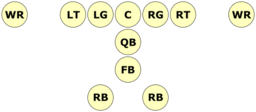
In the 1970s, many college football teams started using the wishbone offense. This was a running play designed to give the quarterback more options. The quarterback could choose to run the ball himself or hand it off to one of two other runners. Fairbanks and his offensive coordinator, Barry Switzer, were among the first to use the wishbone, and it worked very well for them.
Their 1970 team tied with an Alabama team that also used the wishbone. In 1971, the Sooners beat three highly ranked teams in a row. They were ranked second in the country before a big game against top-ranked Nebraska. Nebraska won that game 35–31, which was Oklahoma's only loss that season. Oklahoma finished the season ranked second. Their wishbone offense scored 44.5 points per game and gained a record 472.36 rushing yards per game.
In 1972, the Sooners went 11–1 and finished No. 2. After that season, Fairbanks left Oklahoma to coach in the NFL.
Barry Switzer's Time as Coach (1973–1988)
Switzer became head coach after Fairbanks left. His time started with some rule violations. The university reported that a player's high school records had been changed. Even though the Sooners had to give up eight wins from the 1972 season, the university still recognizes those wins.
The Big Eight conference punished the team with a two-year ban from bowl games and a two-year ban from TV appearances. But during the next three years, Oklahoma went 32–1–1 and won three conference championships in a row. They won back-to-back national championships in 1974 and 1975. These were the two years they couldn't be on TV during the regular season.
Oklahoma did very well during this time. In 1973, they played seven ranked teams, beating six and tying one. In 1974, their running offense averaged 43 points per game. They set an FBS record by running the ball 73.91 times per game. In both 1974 and 1975, six players ran for over 300 yards.
After the 1975 season, many key players left. In 1978, Oklahoma got its third Heisman Trophy winner, Billy Sims. He ran for 1,896 yards. The Sooners finished third in the final AP poll.
During the 1970s, Switzer's teams had a record of 73 wins, 7 losses, and 2 ties. The Sooners won the Big Eight conference every year from 1972 to 1980. But in the early 1980s, the team's performance got worse. They lost four games each year from 1981 to 1983. In 1984, the team improved and won a share of the Big Eight championship.
Switzer's teams were back in the running for the national championship for the next three seasons. They had an 11–1 record and won the Big Eight title each year. However, in all three years, they lost to Miami. In 1985, the Sooners won the national championship despite their loss to Miami. In 1987, the Sooners played in two big games where they were ranked No. 1 or No. 2. They beat top-ranked Nebraska but lost to Miami for the national title.
Switzer's time as coach ended with more rule violations. After the 1988 season, the NCAA put the Sooners on probation for breaking several rules. This included giving players and recruits improper benefits. Switzer faced a lot of pressure and stepped down as head coach in 1989. He finished with a record of 157 wins, 29 losses, and 4 ties. He won 12 conference championships and three national titles.
Coaches Gibbs, Schnellenberger, and Blake (1989–1998)
After Switzer left, the team went through a tough time. Defensive coordinator Gary Gibbs became head coach. During his six years, the team tried to recover from the penalties. They had a combined record of 44 wins, 23 losses, and 2 ties. They never finished higher than second in the conference. Gibbs' teams often lost to rivals like Texas, Nebraska, and Colorado. He announced he would resign before the end of the 1994 season.
Howard Schnellenberger replaced Gibbs. He had won a national championship with Miami. Schnellenberger wanted to completely change the program. His first team started well, reaching No. 10 in the polls. But they ended the year with a tough stretch, including shutout losses to Oklahoma State and Nebraska. Schnellenberger resigned after just one season.
Oklahoma then hired former player John Blake as head coach. Blake had very little coaching experience. In the 101 years before Blake, Oklahoma had only nine losing seasons. Under Blake, the Sooners had three losing seasons in three years. His 12 wins and 22 losses gave him the worst winning percentage of any Oklahoma head coach since the very first one. He was fired after this difficult period.
Even though his coaching record wasn't good, Blake did help the team later on. He recruited several players who would become key starters for the next coach, helping the Sooners become successful again.
Bob Stoops' Era of Success (1999–2016)
The athletic director, Joe Castiglione, needed to find a coach who could turn the team around. He chose Bob Stoops, who was then the defensive coordinator at Florida. Stoops quickly improved the Sooners to a 7–5 record in his first season.
Competing for Championships
Oklahoma started the 2000 season ranked No. 19. This was their first time in the preseason AP poll in five years. After starting 4–0, the Sooners beat Texas 63–14. Running back Quentin Griffin set a school record with six rushing touchdowns in that game. The next week, they beat No. 2 Kansas State, and two weeks later, they defeated top-ranked Nebraska. This period was called "Red October."
The Sooners finished the regular season undefeated. They beat Kansas State in the conference championship game to win their first conference title since 1987. The Big Eight conference had changed to the Big 12. Also, the BCS system was now in place, with a national championship game between the top two teams. Oklahoma was ranked No. 1 and played Florida State in the Orange Bowl for the BCS title. The Sooners won 13–2, claiming the school's seventh national championship.
In the years that followed, Oklahoma continued to compete for conference and national championships. In 2001, they played in the Cotton Bowl Classic for the first time and won. In 2002, the Sooners won the Big 12 and went to the Rose Bowl for the first time, where they won again.
Oklahoma went undefeated in the regular season in both 2003 and 2004. In 2003, they had huge wins over Texas A&M (77–0) and Texas (65–13). This Texas win was the biggest in Red River Rivalry history. Led by Heisman Trophy winner Jason White, OU was ranked No. 1 for most of the season. But they lost the Big 12 Championship Game to Kansas State. Still, they remained No. 1 in the BCS rankings and played for the national championship in the Sugar Bowl, which they lost to LSU.
The next year, freshman running back Adrian Peterson became a star. He ran for 1,925 yards and 15 touchdowns. He finished second in the Heisman voting. Oklahoma was ranked No. 2 for the entire season and played USC for the national championship in the Orange Bowl. Oklahoma lost their second straight national championship game. After the season, many key players left, with 10 Sooners chosen in the 2005 NFL Draft.
Later Years and Playoff Appearances
In 2005, the Sooners were not ranked in the AP poll for the first time in years. But they still finished with an 8–4 record and won the Holiday Bowl. In both 2006 and 2007, the Sooners won the Big 12. However, they lost their bowl games in upsets.
Before the 2007 season, the NCAA announced penalties because players on the 2005 team had received improper benefits. The NCAA said Oklahoma failed to properly oversee these benefits. They punished the team by taking away their wins from the 2005 season. However, in 2008, the NCAA changed its mind and gave the wins back.
The 2008 team scored the most points in college football history at that time, averaging over 51 points per game. Quarterback Sam Bradford won the Heisman Trophy. The Sooners played in the BCS National Championship Game but lost to Florida.
After a Fiesta Bowl win in 2010, the Sooners were ranked No. 1 to start the 2011 season. They became the first team to reach 100 No. 1 rankings in the AP poll.
2011 was the last time the Sooners were ranked No. 1 under Stoops. But Oklahoma remained a strong team. They won the 2014 Sugar Bowl against defending national champions Alabama. The next year, the College Football Playoff started. Four teams are chosen to play in national semifinal games, and the winners go to the championship. The Sooners made their first playoff appearance in 2015 but lost to Clemson in the semifinal. In 2016, they won the Big 12 but didn't make the playoff. They won the Sugar Bowl against Auburn.
In June 2017, Stoops announced he was stepping down as head coach. He said it felt like the right time to retire. His offensive coordinator, Lincoln Riley, immediately became his replacement. During his time at Oklahoma, Stoops had a record of 190 wins and 48 losses. He won 10 conference titles and went to a school-record 18 bowl games. In 2021, he was put into the College Football Hall of Fame.
Riley and Venables: Recent Years (2017–present)
In his first season, Riley led the Sooners to 12 wins. This was the most wins for a first-year coach in program history. The Sooners entered the playoff but lost to Georgia in a close game. 2017 was the first of three straight 12-win seasons for the Sooners under Riley. However, each of these seasons ended with a loss in a College Football Playoff semifinal. As of the end of the 2022 season, Oklahoma has made four playoff appearances but has not won a game. But the Sooners did win four straight Big 12 Championship Games under Riley.
Under Riley, the Sooners had two Heisman Trophy winners in a row. Both of them were later chosen as the first overall pick in the NFL Draft. In 2017, Baker Mayfield won the Heisman. He set a record for passing efficiency and threw for over 4,600 yards and 43 touchdowns. He was picked first in the 2018 NFL Draft. The next season, Kyler Murray won the Heisman, becoming the seventh winner for Oklahoma. He was also picked first in the 2019 NFL Draft. To replace Murray, Riley brought in Jalen Hurts. The Sooners lost to LSU in the Peach Bowl, and Hurts finished second in Heisman voting.
In July 2021, Oklahoma and Texas announced they would leave the Big 12 conference for the Southeastern Conference (SEC) in 2024. This surprising move caused many other teams to change conferences. Oklahoma and Texas were criticized for leaving their old conference. In February 2023, the two universities paid a combined $100 million fee to leave the Big 12 a year early. Oklahoma and Texas are now set to start playing in the SEC in the 2024 season.
Before the end of the 2021 season, Riley accepted a coaching job at USC. This was the first time an Oklahoma head coach left for another job since 1973. During his time at Oklahoma, Riley had a record of 55 wins and 10 losses, which is the highest winning percentage for any coach in program history. Bob Stoops was named interim head coach for the team's bowl game and led them to a win. Brent Venables, who used to be a defensive coordinator at Oklahoma, was hired as Riley's replacement. In his first year, the Sooners finished 6–7. This included a tough 49–0 loss to Texas, which was Oklahoma's worst loss in the Red River Rivalry. The 2023 season saw Oklahoma finish 10–3, ending with a bowl game loss. That game marked the end of OU's time in the Big 12.
Conference History
Oklahoma has been an independent team and a member of four different conferences:
- Independent (1895–1914)
- Southwest Conference (1915–1919)
- Big Eight Conference (1920–1995)
- Big 12 Conference (1996–2023)
- Southeastern Conference (2024–present)
Championships Won by Oklahoma
National Championships
Oklahoma claims seven national championships. These were won when they were chosen as the top team in major college football polls. They also have ten other years where they were ranked highly by other systems, but they do not officially claim those as national championships.
Official National Championships
| Season | Coach | Selector(s) | Record | Bowl | Opponent | Result | Final AP | Final Coaches' |
|---|---|---|---|---|---|---|---|---|
| 1950 | Bud Wilkinson | AP, Berryman, Helms, Litkenhous, UPI Coaches, Williamson | 10–1 | Sugar Bowl | Kentucky | L 7–13 | No. 1 | No. 1 |
| 1955 | AP, Berryman, Billingsley, DeVold, Dunkel, Football Research, FW, Helms, INS, Litkenhous, National Championship Foundation, Poling, Sagarin, Sagarin (ELO-Chess), UPI coaches, Williamson | 11–0 | Orange Bowl | Maryland | W 20–6 | |||
| 1956 | AP, Billingsley, Boand, DeVold, Dunkel, FW, Helms, INS, Litkenhous, National Championship Foundation, Sagarin, UPI coaches, Williamson | 10–0 | ||||||
| 1974 | Barry Switzer | AP, Berryman, Billingsley, DeVold, Dunkel, FACT, FB News, Football Research, Helms*, Litkenhous, National Championship Foundation*, Poling, Sagarin, Sagarin (ELO-Chess) | 11–0 | – | ||||
| 1975 | AP, Billingsley, DeVold, Dunkel, FACT*, FB News, Football Research, FW, Helms*, National Championship Foundation*, NFF, Sagarin, Sagarin (ELO-Chess), UPI Coaches | 11–1 | Orange Bowl | Michigan | W 14–6 | No. 1 | ||
| 1985 | AP, Berryman, Billingsley, DeVold, Dunkel, FACT, FB News, Football Research, FW, National Championship Foundation, NFF, NY Times, Sagarin*, Sporting News, UPI, USA/CNN coaches | 11–1 | Orange Bowl | Penn State | W 25–10 | |||
| 2000 | Bob Stoops | AP, Berryman, BCS, Billingsley, DeVold, Dunkel, Eck, FACT, FB News, FW, Massey, Matthews, National Championship Foundation, NFF, Sagarin, Sagarin (ELO-Chess), Seattle Times, Sporting News, USA/ESPN | 13–0 | Orange Bowl (BCS National Championship Game) | Florida State | W 13–2 |
- * retrospective selection
Other National Championship Selections
Oklahoma does not officially claim these seasons as national championships.
| Season | Coach | Selector(s) | Record | Bowl | Opponent | Result |
|---|---|---|---|---|---|---|
| 1915 | Bennie Owen | Billingsley MOV | 10–0 | |||
| 1949 | Bud Wilkinson | Football Research | 11–0 | Sugar Bowl | LSU | W 35–0 |
| 1953 | Berryman, Football Research | 9–1–1 | Orange Bowl | Maryland | W 7–0 | |
| 1957 | Berryman | 10–1 | Orange Bowl | Duke | W 48–21 | |
| 1967 | Chuck Fairbanks | Poling | 10–1 | Orange Bowl | Tennessee | W 26–24 |
| 1973 | Barry Switzer | DeVold, Dunkel, Football Research, Sagarin | 10–0–1 | |||
| 1978 | DeVold, Dunkel, FACT, Helms, Litkenhous, Matthews, Poling, Rothman, Sagarin | 11–1 | Orange Bowl | Nebraska | W 31–24 | |
| 1980 | Dunkel, Matthews | 10–2 | Orange Bowl | Florida State | W 18–17 | |
| 1986 | Berryman, DeVold, Dunkel, Football Research, NY Times, Sagarin | 11–1 | Orange Bowl | Arkansas | W 42–8 | |
| 2003 | Bob Stoops | Berryman | 12–2 | BCS Nat'l Championship Game | LSU | L 14–21 |
Conference Championships
The team has won 50 conference titles. They even won 14 in a row from 1946 to 1959!
| # | Season | Conference | Coach | Overall Record | Conference Record |
|---|---|---|---|---|---|
| 1 | 1915 | Southwest | Bennie Owen | 10–0 | 3–0 |
| 2 | 1918 † | 6–0 | 2–0 | ||
| 3 | 1920 | MVIAA | 6–0–1 | 4–0–1 | |
| 4 | 1938 | Big 6 | Tom Stidham | 10–1 | 5–0 |
| 5 | 1943 | Dewey Luster | 7–2 | 5–0 | |
| 6 | 1944 | 6–3–1 | 4–0–1 | ||
| 7 | 1946 † | Jim Tatum | 8–3 | 4–1 | |
| 8 | 1947 † | Bud Wilkinson | 7–2–1 | 4–0–1 | |
| 9 | 1948 | Big 7 | 10–1 | 5–0 | |
| 10 | 1949 | 11–0 | 5–0 | ||
| 11 | 1950 | 10–1 | 6–0 | ||
| 12 | 1951 | 8–2 | 6–0 | ||
| 13 | 1952 | 8–1–1 | 5–0 | ||
| 14 | 1953 | 9–1–1 | 6–0 | ||
| 15 | 1954 | 10–0 | 6–0 | ||
| 16 | 1955 | 11–0 | 6–0 | ||
| 17 | 1956 | 10–0 | 6–0 | ||
| 18 | 1957 | 10–1 | 6–0 | ||
| 19 | 1958 | Big 8 | 10–1 | 6–0 | |
| 20 | 1959 | 7–3 | 5–1 | ||
| 21 | 1962 | 8–3 | 7–0 | ||
| 22 | 1967 | Chuck Fairbanks | 10–1 | 7–0 | |
| 23 | 1968 † | 7–4 | 6–1 | ||
| 24 | 1972 ‡ | 11–1 | 6–1 | ||
| 25 | 1973 | Barry Switzer | 10–0–1 | 7–0 | |
| 26 | 1974 | 11–0 | 7–0 | ||
| 27 | 1975 † | 11–1 | 6–1 | ||
| 28 | 1976 † | 9–2–1 | 6–1 | ||
| 29 | 1977 | 10–2 | 7–0 | ||
| 30 | 1978 † | 11–1 | 6–0 | ||
| 31 | 1979 | 11–1 | 7–0 | ||
| 32 | 1980 | 10–2 | 7–0 | ||
| 33 | 1984 † | 9–2–1 | 6–1 | ||
| 34 | 1985 | 11–1 | 7–0 | ||
| 35 | 1986 | 11–1 | 7–0 | ||
| 36 | 1987 | 11–1 | 7–0 | ||
| 37 | 2000 | Big 12 | Bob Stoops | 13–0 | 8–0 |
| 38 | 2002 | 12–2 | 6–2 | ||
| 39 | 2004 | 12–1 | 8–0 | ||
| 40 | 2006 | 11–3 | 7–1 | ||
| 41 | 2007 | 11–3 | 6–2 | ||
| 42 | 2008 | 12–2 | 7–1 | ||
| 43 | 2010 | 12–2 | 6–2 | ||
| 44 | 2012 † | 10–3 | 8–1 | ||
| 45 | 2015 | 11–2 | 8–1 | ||
| 46 | 2016 | 11–2 | 9–0 | ||
| 47 | 2017 | Lincoln Riley | 12–2 | 8–1 | |
| 48 | 2018 | 12–2 | 8–1 | ||
| 49 | 2019 | 12–2 | 8–1 | ||
| 50 | 2020 | 9–2 | 6–2 |
† Co-championship
‡ Both Nebraska and Oklahoma claim the 1972 championship. Oklahoma had to give up eight games from the 1972 season and the Big 8 title due to rule violations.
Division Championships
The Sooners have only been part of one division, the Big 12 South. They were members from 1996 until 2010, when the Big 12 stopped having divisions.
| Season | Division | Coach | Overall Record | Conference Record | Opponent | CG result |
|---|---|---|---|---|---|---|
| 2000 | Big 12 South | Bob Stoops | 13–0 | 8–0 | Kansas State | W 27–24 |
| 2002 † | 12–2 | 6–2 | Colorado | W 29–7 | ||
| 2003 | 12–2 | 8–0 | Kansas State | L 7–35 | ||
| 2004 | 12–1 | 8–0 | Colorado | W 42–3 | ||
| 2006 | 11–3 | 7–1 | Nebraska | W 21–7 | ||
| 2007 | 11–3 | 6–2 | Missouri | W 38–17 | ||
| 2008 † | 12–2 | 7–1 | Missouri | W 62–21 | ||
| 2010 † | 12–2 | 6–2 | Nebraska | W 23–20 |
† Co-championship
Bowl Games Played
Head Coaches of the Sooners
The Sooners have had 23 head coaches in their history. The current head coach, Brent Venables, was hired on December 5, 2021. Since the first coach, John A. Harts, led the team for one game in 1895, the Sooners have played over 1,300 games. Four coaches have led the team in more than 100 games, and all of them have won over 100 games at Oklahoma. Oklahoma is the only team with four coaches who have won 100 or more games.
The coach with the best winning percentage in school history is Lincoln Riley, who had 55 wins and 10 losses. The coach with the lowest winning percentage (besides Harts, who lost his only game) is John Blake, who had 12 wins and 22 losses. Ten coaches have led the Sooners to postseason bowl games. Nine coaches have won conference championships with the Sooners. Wilkinson, Switzer, and Stoops have all been named National Coach of the Year. Six Sooner coaches are in the College Football Hall of Fame.
Current Coaching Staff
| Name | Position | Consecutive season at Oklahoma in current position | Previous position |
|---|---|---|---|
| Seth Littrell | Offensive coordinator/ Quarterbacks | 1st | Oklahoma - Offensive Analyst (2023). |
| Joe Jon Finley | Co-offensive coordinator / Tight end | 3rd | Ole Miss – Passing game coordinator / tight ends (2020) |
| Zac Alley | Co-Defensive coordinator/Linebackers | 1st | Jacksonville State – Defensive Coordinator (2022) |
| Todd Bates | Associate head coach / co–defensive coordinator / run defense / defensive tackles | 2nd | Clemson – Defensive tackles / recruiting coordinator (2020–2021) |
| Jay Valai | Assistant Head Coach for Defense / Co-Defensive Coordinator / Pass Defense / Cornerbacks and Nickelbacks | 2nd | Alabama – Cornerbacks (2021) |
| Emmett Jones | Wide receivers Coach and Passing Game Coordinator | 1st | Texas Tech – Wide Receivers Coach and Passing Game Coordinator (2022) |
| Bill Bedenbaugh | Offensive line | 11th | Oklahoma – Co–offensive coordinator / offensive line (2017–2021) |
| DeMarco Murray | Running backs | 4th | Arizona – Running backs (2019) |
| Miguel Chavis | Defensive ends | 2nd | Clemson – Defensive player development (2017–2021) |
| Brandon Hall | Safeties | 2nd | Troy – Interim head coach / defensive coordinator / safeties (2021) |
| Jerry Schmidt | Director of sport enhancement / strength & conditioning | 2nd | Texas A&M – Director of athletic performance (2018–2021) |
| Reference: | |||
Home Stadium: The Palace on the Prairie
The Sooners play their home games at Gaylord Family Oklahoma Memorial Stadium. It's also known as The Palace on the Prairie. The stadium used to be called Oklahoma Memorial Stadium. The name 'Gaylord Family' was added to honor the contributions of Edward K. Gaylord and his family. The playing field is called Owen Field, named after Bennie Owen, Oklahoma's coach from 1905 to 1926.
The stadium was built in 1923 and could originally hold only 500 people. In 1925, 16,000 seats were added, and another 16,000 seats were added in 1929, bringing the total to 32,000. The stadium has mostly had a natural grass field. It had artificial turf from 1970 to 1994. A big renovation happened in 2003, adding over 8,400 new seats. After renovations in 2015, the official seating capacity is 83,489. This makes it the 15th largest college stadium in the U.S. The Sooners often have more fans than the official capacity, with an average of 86,735 for the 2018 season. The largest crowd ever was 88,308 on November 11, 2017.
Big Rivalries
Missouri Tigers Football
Oklahoma leads their inactive series against the Missouri Tigers with 67 wins, 24 losses, and 5 ties. The last game was played in 2011. This rivalry is set to start again in 2024, which will be Oklahoma's first season in the Southeastern Conference.
Nebraska Cornhuskers Football
When they were both in the Big Eight Conference, Oklahoma's rivalry with the Nebraska Cornhuskers often decided who would win the conference or even the national championship. These two teams, who often played on Thanksgiving, won a combined 77 conference titles between 1907 and 1995. They are famous for a 1971 game called the "Game of the Century," which Nebraska won 35–31.
In 1996, when they joined the Big 12 Conference, they were placed in different divisions, so they stopped playing every year. However, they still had big games, including a 2000 game where both teams were ranked very high. They played for the Big 12 championship twice, in 2006 and 2010, with Oklahoma winning both. After Nebraska moved to the Big Ten Conference, the rivalry became a non-conference game and is played less often. Oklahoma leads the series 47–38–3, having won the last three games. The next game is planned for 2029.
Oklahoma State Cowboys Football (Bedlam Series)
Oklahoma has usually dominated their series against the Oklahoma State Cowboys. Oklahoma leads the series 91–20–7 through the end of the 2023 season. The first game was in 1904. Oklahoma State didn't even score a point against the Sooners until 1914, in their ninth game. Oklahoma won 19 straight Bedlam games from 1946 to 1964. They also had a record of 26 wins, 1 loss, and 1 tie from 1967 to 1994. However, Oklahoma State has won two of the last three games.
Because Oklahoma is moving to the Southeastern Conference, this rivalry is not expected to continue for a while. Oklahoma State's coach, Mike Gundy, said the rivalry is "history" and that there's no room for the game in their schedule until after 2037.
Texas Longhorns Football (Red River Rivalry)
The Red River Rivalry game is played every year in Dallas during the State Fair of Texas. It's between Oklahoma and the Texas Longhorns. Since 1929, the game has been played at the Cotton Bowl. This stadium is about halfway between Norman and Austin. The stadium is split in half for the game, with Oklahoma fans on one side and Texas fans on the other.
For most of the 20th century, this was a non-conference game. In 1996, both teams became part of the Big 12 Conference's South division. That year, Oklahoma won the first overtime game in the series. In 2024, both teams will move to the Southeastern Conference, and the rivalry will continue there. Oklahoma leads the series 63–51–5 through the end of the 2023 regular season.
Team Spirit and Traditions
School Colors
| Crimson | Cream |
Oklahoma's official school colors are crimson and cream. These colors were chosen in 1895 by May Overstreet, who was the only female teacher at the time. She picked them after looking at many color samples. The students loved her choices and approved them.
Mascots and Traditions
Oklahoma has had a few mascots over the years. The first was a stray dog named Mex. Mex was found in Mexico during a war by a soldier. The soldier brought Mex to Oklahoma when he enrolled in the university. Mex's main job during games was to keep other stray dogs off the field. He wore a red sweater with a big "O" on it. Mex became famous in 1924 when the team lost a game after he got lost. People blamed the loss on losing their mascot! Mex was found later. He died in 1928, and classes were canceled on the day of his funeral. He was buried under the stadium.
Another unofficial mascot, Little Red, started appearing at games in 1953. He was a person dressed as an Indian in red tights and a war bonnet. In 1970, the university president decided Little Red should no longer appear. Even though there was a court order, the person playing Little Red showed up for the first game of the 1970 season and was cheered by the crowd. After he left in 1971, no one tried out to replace him.
The official mascot for Oklahoma is the Sooner Schooner. This is a covered wagon, like the ones early settlers used in Oklahoma. The Schooner is driven by members of the RUF/NEKS, an all-male spirit group, along with two white ponies named Boomer and Sooner. In 2005, the university also introduced two costumed mascots, also named Boomer and Sooner. They are used for games and events where the wagon can't go.
Team Music
The official fight song of the Sooners is "Boomer Sooner." This song is played often at football games. The band plays it after touchdowns, field goals, and big plays. "OK Oklahoma" is another school song played after an extra point and when the Sooner Schooner comes onto the field. The official Alma Mater song is the "OU Chant". OU fans sing this before games and at special events. Other songs heard at games include the state song "Oklahoma" and "Fight for OKU."
The Pride of Oklahoma Marching Band is a very famous band that started in 1904. It's the largest student group on campus. The band plays at all home games and often travels to other games.
Awards and Honors
Heisman Trophy Winners
The Heisman Trophy is given every year to the best college football player in the country. Seven Oklahoma players have won the Heisman Trophy: Billy Vessels, Steve Owens, Billy Sims, Jason White, Sam Bradford, Baker Mayfield, and Kyler Murray. Oklahoma is tied with Notre Dame and Ohio State for the second most Heisman wins. Only USC has more. Oklahoma is also tied for the most times a player has finished second in the Heisman voting, with six players.
| Year | Player | Position | Points | Notes |
|---|---|---|---|---|
| 1952 | Billy Vessels | Halfback | 525 | |
| 1969 | Steve Owens | Running back | 1,488 | |
| 1978 | Billy Sims | Running back | 827 | |
| 2003 | Jason White | Quarterback | 1,481 | |
| 2008 | Sam Bradford | Quarterback | 1,726 | |
| 2017 | Baker Mayfield | Quarterback | 2,398 | |
| 2018 | Kyler Murray | Quarterback | 2,167 |
Other Major Awards
|
|
|
|
||||||||||||||||||||||||||||||||||||||||||||||||||||||||||||||||||||||||||||||||||||||||||||||||||||||||||||||||||||||||||||
All-Americans from Oklahoma
Every year, different groups name the best college football players in the country. These players are called All-Americans. The NCAA recognizes five main All-American lists. A "consensus All-American" is usually a player named to three or more of these lists. A "unanimous All-American" means they were named to all five lists. Oklahoma has had 167 first-team All-Americans in its history. Of these, 82 were consensus All-Americans, and 35 were unanimous selections.
College Football Hall of Fame Inductees
Oklahoma has 29 people in the College Football Hall of Fame. This includes 23 players and 6 coaches. The first person from Oklahoma to be inducted was coach Bennie Owen in 1951. The most recent is Roy Williams, who was inducted in 2022.
| Name | Position | Tenure | Inducted |
|---|---|---|---|
| Brian Bosworth | LB | 1984–1986 | 2015 |
| Tom Brahaney | C | 1970–1972 | 2007 |
| Kurt Burris | C | 1951–1954 | 2000 |
| Tony Casillas | DL | 1982–1985 | 2004 |
| Rickey Dixon | CB | 1984–1987 | 2019 |
| Forest Geyer | FB | 1913–1915 | 1973 |
| Keith Jackson | TE | 1984–1987 | 2001 |
| Biff Jones | Coach | 1934–1936 | 1954 |
| Tommy McDonald | WR | 1954–1956 | 1985 |
| Bennie Owen | Coach | 1905–1926 | 1951 |
| Steve Owens | RB | 1967–1969 | 1991 |
| Jim Owens | TE | 1946–1949 | 1982 |
| Greg Pruitt | RB | 1970–1972 | 1999 |
| Claude Reeds | FB | 1910–1912 | 1961 |
| J. D. Roberts | OG | 1951–1953 | 1993 |
| Rod Shoate | LB | 1972–1974 | 2013 |
| Barry Switzer | Coach | 1973–1988 | 2001 |
| Lee Roy Selmon | DE | 1972–1975 | 1988 |
| Billy Sims | RB | 1975–1978 | 1995 |
| Bob Stoops | Coach | 1999–2016 | 2021 |
| Jim Tatum | Coach | 1946 | 1984 |
| Clendon Thomas | RB/DB | 1955–1957 | 2011 |
| Jerry Tubbs | C/LB | 1954–1956 | 1996 |
| Billy Vessels | RB | 1950–1952 | 1974 |
| Jim Weatherall | OT | 1949–1951 | 1992 |
| Joe Washington | RB | 1972–1975 | 2005 |
| Bud Wilkinson | Coach | 1947–1963 | 1969 |
| Roy Williams | DB | 1999–2001 | 2022 |
| Waddy Young | End | 1936–1938 | 1986 |
Future Games
2025 SEC Conference Schedule
| Opponent | Site | Result |
|---|---|---|
| at Alabama | ||
| Auburn |
|
|
| LSU |
|
|
| Missouri |
|
|
| Ole Miss |
|
|
| at South Carolina |
|
|
| at Tennessee |
|
|
| vs. Texas |
|
Non-Conference Games
Here are the non-conference games that have been announced as of August 11, 2023.
| 2025 | 2026 | 2027 | 2028 | 2029 | 2030 | 2031 | 2032 | 2033 | 2034 | 2035 | 2036 |
|---|---|---|---|---|---|---|---|---|---|---|---|
| Illinois State (FCS) | UTEP | at SMU | Temple | at San Diego State | Tulsa | San Diego State | — | Tulsa | — | at Clemson | Clemson |
| Michigan | at Michigan | San Diego State | at Houston | Nebraska | at Nebraska | — | — | — | — | — | — |
| at Temple | New Mexico | — |
Colorado State |
— | — | — | — | — | — | — | — |
| Kent State | — | — | — | — | — | — | — | — | — | — | — |
More About Oklahoma Sooners
- The Pride of Oklahoma Marching Band
- RUF/NEKS
- OU Chant
- List of Oklahoma Sooners in the NFL Draft
- Play Like a Champion Today





